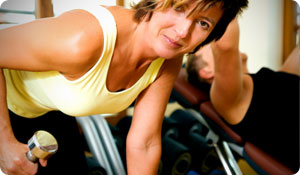
As any individual who exercises can attest, muscle soreness is proof that your body is responding to the new or increased physical challenge. However, when arthritis muscle soreness and pain is part of your daily life, it's no longer a sign of accomplishment. While intense exercise can induce muscle soreness and pain, it can also provide relief from arthritis symptoms.
Pain and Muscle Soreness
Pain is your body's way of telling you something is wrong. It may be acute, occurring immediately after an injury, or chronic, which is often disease related and harder to relieve. Arthritis causes your muscle cells to work at maximum capacity during normal daily activities, whereas a person who doesn't have a disease only reaches this performance--limiting threshold during extensive activity.
Exercise that leads to muscle soreness and pain increases certain enzymes in the blood. This causes inflammation and structural damage and leads to a decrease in range of motion and strength. This is also called delayed onset muscle soreness. It starts 24 to 48 hours after exercise and peaks after 48 hours.
Numerous studies demonstrate that sustained, moderate or high-intensity strength training is effective and well tolerated in patients with rheumatoid arthritis. Your strength-training activities must exceed normal daily workloads to be effective. Strength exercises improve joint stability and decrease pain.
Is Your Pain Normal?
So how do you know if your muscle soreness and pain is part of the normal strength training process or an indication of something serious?
First, respect pain and don't ignore it. It's your body's alarm system. Start your exercise routine slowly and gradually increase intensity. If you have pain in a specific joint area prior to exercising, skip that part of the body and focus on another area. Sharp or intense pain is a sign you should stop exercising immediately. If you consistently have joint pain after exercise, find an alternative exercise that is less stressful on those joints. Back off on the intensity of your workout if you experience delayed onset muscle soreness. A cool-down phase at the end of your workout period will also reduce the likelihood of sore or painful muscles.
Yoga is a great option for people with arthritis. It helps build muscle strength while also stretching muscles and providing relief from soreness. The deep breathing that accompanies yoga postures delivers extra oxygen to your tissues and muscles. Yoga exercises help prevent injuries by keeping your muscles, tendons and ligaments flexible.
If you experience muscle soreness or pain, try heat or ice, rest and massage therapy until you recover.
Sources:
http://www.arthritis.org/understanding-pain.php
http://www.medicalnewstoday.com/articles/169194.php
http://www.arthritistoday.org/fitness/motivation/exercise-pain.php
http://www.yogawiz.com/blog/yoga-benefits/yoga-to-gain-muscle.html





